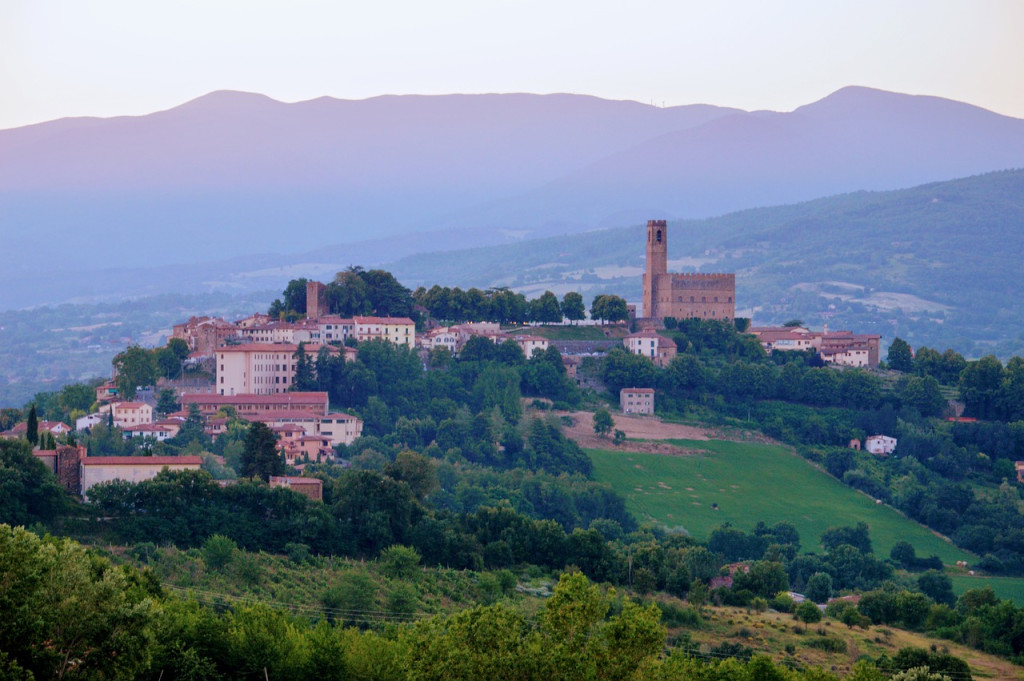The Casentino Valley Area Amidst Castles and Nature
The Casentino Valley, one of the four valleys of Arezzo, region offers views reminiscent of untouched Renaissance frescoes with enchanting towns. Here, the Apennine peaks are snow-covered in winter, and ruins of ancient castles remind us of tumultuous eras.
The renowned Casentino Forest National Park is a world-famous Italian pride, offering unforgettable hiking and trekking opportunities. Walking among its ancient trees, echoes of the past and legends resonate, including tales of Badalischio and the heroic – yet very real – Telda the Warrior. It was in this setting that Dante Alighieri found refuge and inspiration for his Divine Comedy, also bravely fighting in the Battle of Campaldino near Poppi, one of Italy’s most beautiful villages.
Poppi: A Jewel of the Casentino
In the heart of Poppi stands the majestic Castle of the Conti Guidi, dominating the town and surrounding countryside. The Conti Guidi, who built the Poppi Castle in the 12th century, were responsible for this and other fortresses in Casentino Valley.
From its commanding position, the Castle offered strategic advantages known since Roman times. It’s believed that “Poppi” comes from “POPLO,” meaning “Hill.” Speaking of hills and military strategy: inside the Castle, you can admire a splendid model of the Battle of Campaldino! But Poppi’s beauty extends beyond the Castle. Nearby, on the opposite side of the village, the Abbey of San Fedele stands magnificently with its artistic treasures and striking architecture.
Camaldoli: A Peaceful Oasis
Regarding sacredness, Camaldoli, surrounded by mountain forest, is a pure haven of peace and beauty. Here, the Hermitage of Camaldoli, founded by Saint Romuald in 1027, emerges from the woods like a slice of paradise.
But Camaldoli offers more than spirituality and untouched nature. Excursions often culminate in tasting delicious local products. Indeed, Camaldoli is home to the most famous Schiacciata in Casentino Valley, drawing gourmets from the valley and beyond.
Pratovecchio and Stia: Between Tradition and Progress in Casentino
Pratovecchio and Stia are among the most picturesque towns in Casentino Valley. The legacy of the Conti Guidi is palpable, especially in Romena, where the ruins of the ancient castle tell stories of chivalry and battles. Nearby stands the Pieve di Romena, believed to have been built by Matilde di Canossa.
Stia, on the other hand, blends past and future: from the Castle of Porciano to the Palagio Fiorentino, history walks hand in hand with the present. In Stia, the Wool Art Museum reflects the Casentino wool tradition, housed within the restored and revalorized old wool mill.
The Small Soci
In the context of wool processing, it’s essential to mention the small village of Soci, part of Bibbiena, playing a key role in the industry even today. For centuries, the art of spinning has flourished here, culminating in the creation of the renowned Casentino Cloth. This fabric, made with traditional “Carding,” has gained global recognition and is proudly exported from Soci worldwide as a prestigious product.
The Beauty of Casentino: More Than Architecture
Casentino Valleyoffers surprises that go beyond architectural beauties, castles, and ruins. We will delve into other wonders in future articles, but it’s essential to mention immediately the rich culinary tradition of Casentino Valley. The valley was once the border of the Lombard dominion, and the culinary tradition is accordingly divided in two.
On one side is the typical fresh pasta of Tuscany (with pappardelle leading the way), and on the other, stuffed pasta, with unique products like the Tortelli di Patate alla Lastra. In Cetica, a D.O.P. type of potato has gained global recognition. Not to forget the incomparable Grigio del Casentino, a D.O.P. pig breed that expert Casentino butchers transform into exquisite products.
Discover the Magic of Casentino
Casentino Valleyis a territory deserving much attention. The oldest Tuscan traditions still live here, cherished by a local population aware of their past’s value. Numerous eco-museums (such as the Carbonaio ecomuseum in Cetica) and consortia enhance ancient crafts and gastronomic traditions. B&B Cento Passi dal Duomo will continue exploring the valley with more articles and advises you to deepen your knowledge of this wonderful land with a visit.

